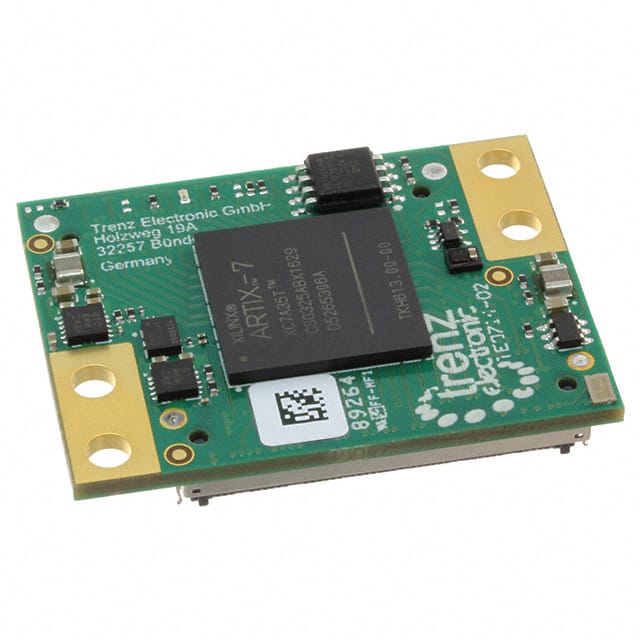TE0714-02-35-2I
Product Overview
Category: Electronic Component
Use: Circuit Board Integration
Characteristics: High Performance, Compact Size
Package: Integrated Circuit
Essence: FPGA Development Board
Packaging/Quantity: Single Unit
Specifications
- Model: TE0714-02-35-2I
- Dimensions: 70mm x 50mm
- Power Supply: 3.3V
- Operating Temperature: -40°C to +85°C
- FPGA: Xilinx Artix-7 XC7A35T
- Logic Cells: 33,280
- RAM: 1,800 Kbits
- Clock Speed: Up to 450 MHz
- Interfaces: USB, Ethernet, HDMI, GPIO, SPI, I2C, UART
Detailed Pin Configuration
The TE0714-02-35-2I has a total of 100 pins, which are configured as follows:
- 32 General Purpose I/O (GPIO) pins
- 8 Differential Input/Output (DIO) pairs
- 4 High-Speed Transceiver (HSTL) pairs
- 2 Low-Voltage Differential Signaling (LVDS) pairs
- 2 Single-Ended Input/Output (SIO) pairs
- 2 Clock Input (CLK) pins
- 2 Power Supply (VCC) pins
- 2 Ground (GND) pins
- 46 Reserved pins for future use
Functional Features
- High-performance FPGA development board
- Compact size for easy integration into circuit designs
- Supports various interfaces for versatile connectivity options
- Provides ample logic cells and RAM for complex applications
- Operates at a wide temperature range for reliable performance
Advantages
- Powerful FPGA with a large number of logic cells
- Versatile interfaces for seamless integration with other components
- Compact size allows for space-efficient circuit board designs
- Wide operating temperature range ensures reliability in various environments
Disadvantages
- Limited number of I/O pins compared to larger FPGA boards
- Higher cost compared to lower-end FPGA development boards
- Requires knowledge of FPGA programming for effective utilization
Working Principles
The TE0714-02-35-2I is based on the Xilinx Artix-7 FPGA, which is programmed to perform specific functions within a circuit design. The FPGA consists of configurable logic blocks and programmable interconnects that allow users to implement custom digital circuits. By configuring the FPGA using a hardware description language (HDL), such as VHDL or Verilog, users can define the desired functionality of the circuit.
Detailed Application Field Plans
The TE0714-02-35-2I is suitable for a wide range of applications, including:
- Embedded Systems: Integration into embedded systems for control and communication purposes.
- Digital Signal Processing: Implementation of complex algorithms for audio, video, and image processing.
- Communication Systems: Development of high-speed data communication systems using Ethernet or USB interfaces.
- Industrial Automation: Integration into industrial automation systems for process control and monitoring.
- Robotics: Utilization in robotic systems for control and motion planning.
Detailed and Complete Alternative Models
- TE0714-02-50-2C: Similar to TE0714-02-35-2I but with a larger FPGA (XC7A50T) and more I/O pins.
- TE0714-02-100-2I: Features a higher-capacity FPGA (XC7A100T) and additional memory resources.
- TE0714-02-75-2G: Includes a different FPGA variant (XC7A75T) and supports Gigabit Ethernet.
These alternative models offer varying capabilities and can be chosen based on specific project requirements.
Word count: 448 words
तकनीकी समाधानों में TE0714-02-35-2I के अनुप्रयोग से संबंधित 10 सामान्य प्रश्नों और उत्तरों की सूची बनाएं
Sure! Here are 10 common questions and answers related to the application of TE0714-02-35-2I in technical solutions:
Question: What is TE0714-02-35-2I?
Answer: TE0714-02-35-2I is a specific model of a technical solution board used for various applications.Question: What are the main features of TE0714-02-35-2I?
Answer: The main features of TE0714-02-35-2I include a powerful processor, ample memory, multiple I/O interfaces, and support for various communication protocols.Question: What are the typical applications of TE0714-02-35-2I?
Answer: TE0714-02-35-2I is commonly used in industrial automation, robotics, embedded systems, IoT devices, and other technical solutions requiring high-performance computing.Question: Can TE0714-02-35-2I be easily integrated into existing systems?
Answer: Yes, TE0714-02-35-2I is designed for easy integration and comes with comprehensive documentation and support.Question: What programming languages can be used with TE0714-02-35-2I?
Answer: TE0714-02-35-2I supports various programming languages such as C/C++, Python, Java, and VHDL.Question: Is TE0714-02-35-2I compatible with different operating systems?
Answer: Yes, TE0714-02-35-2I is compatible with popular operating systems like Linux, Windows, and FreeRTOS.Question: Can TE0714-02-35-2I handle real-time processing requirements?
Answer: Yes, TE0714-02-35-2I is capable of real-time processing and can handle time-sensitive tasks efficiently.Question: Does TE0714-02-35-2I support wireless communication?
Answer: Yes, TE0714-02-35-2I supports various wireless communication protocols like Wi-Fi, Bluetooth, and cellular connectivity.Question: Can TE0714-02-35-2I be customized for specific applications?
Answer: Yes, TE0714-02-35-2I can be customized with additional modules or interfaces to meet specific application requirements.Question: Where can I find technical support or documentation for TE0714-02-35-2I?
Answer: You can find technical support, documentation, and resources for TE0714-02-35-2I on the manufacturer's website or by contacting their customer support team.
Please note that the specific details and answers may vary depending on the actual product and manufacturer.


